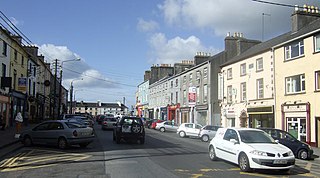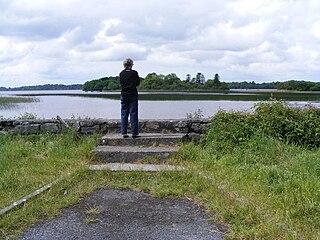
Hever Castle is located in the village of Hever, Kent, near Edenbridge, 30 miles (48 km) south-east of London, England. It began as a country house, built in the 13th century. From 1462 to 1539, it was the seat of the Boleyn family.

Field Marshal John Standish Surtees Prendergast Vereker, 6th Viscount Gort, was a senior British Army officer. As a young officer during the First World War, he was decorated with the Victoria Cross for his actions during the Battle of the Canal du Nord. During the 1930s he served as Chief of the Imperial General Staff. He is best known for commanding the British Expeditionary Force that was sent to France in the first year of the Second World War, only to be evacuated from Dunkirk the following year. Gort later served as Governor of Gibraltar and Malta, and High Commissioner for Palestine and Transjordan.

Viscount Gough, of Goojerat in the Punjab and of the city of Limerick, was a title in the Peerage of the United Kingdom. It was created in 1849 for the Anglo-Irish military commander Hugh Gough, 1st Baron Gough, whose military successes included the First Opium War, the First Anglo-Sikh War, and the Second Anglo-Sikh War. He had already been created a baronet, of Synone and Drangan, in the Baronetage of the United Kingdom, on 23 December 1842, and Baron Gough, of ChingKangFoo in China and of Maharajpore and the Sutlej in the East Indies, in 1846, also in the Peerage of the United Kingdom. Lord Gough later became a field marshal. The titles became extinct in 2023 following the death of the 5th Viscount.

Field Marshal Hugh Gough, 1st Viscount Gough, was a senior British Army officer. After serving as a junior officer at the seizure of the Cape of Good Hope during the French Revolutionary Wars, Gough commanded the 2nd Battalion of the 87th Regiment of Foot during the Peninsular War. After serving as commander-in-chief of the British forces in China during the First Opium War, he became Commander-in-Chief, India and led the British forces in action against the Marathas defeating them decisively at the conclusion of the Gwalior campaign and then commanded the troops that defeated the Sikhs during both the First Anglo-Sikh War and the Second Anglo-Sikh War.

Gort is a town of around 2,800 inhabitants in County Galway in the west of Ireland. Located near the border with County Clare, the town lies between the Burren and the Slieve Aughty and is served by the R458 and R460 regional roads, which connect to the M18 motorway.

Ó Seachnasaigh, O'Shaughnessy, collectively Uí Sheachnasaigh, clan name Cinél nAedha na hEchtghe, is a family surname of Irish origin. The name is found primarily in County Galway and County Limerick. Their name derives from Seachnasach mac Donnchadh, a 10th-century member of the Uí Fiachrach Aidhne, which the Ó Seachnasaigh were the senior clan of. The town of Gort, Ireland, was the main residence of the family since at least the time of their ancestor, King Guaire Aidne mac Colmáin.

Portumna is a market town in the south-east of County Galway, Ireland, on the border with and linked by a bridge to County Tipperary. The town is located to the west of the point where the River Shannon enters Lough Derg. This historic crossing point over the River Shannon between counties Tipperary and Galway has a long history of bridges and ferry crossings. On the south-western edge of the town lie Portumna Castle and Portumna forest park.

Castle Ward is an 18th-century National Trust property located near the village of Strangford, in County Down, Northern Ireland, in the townland of the same name. It overlooks Strangford Lough and is 7 miles from Downpatrick and 1.5 miles from Strangford.
This is a list of people who have held the post of Lord Lieutenant of County Galway.
Roxborough is a townland in County Limerick, Ireland comprising some 24.02 km2. It lies to the south of the townlands of Ballysheedy and Routagh and to the east of the townland of Ballyclough. Its northern boundary, partially bounded by the Ballyclough River, lies some three kilometres to the south of the Limerick City boundary at Southill. The Limerick to Fedamore road (R511) bounds the west side of Roxborough.

East Cowes Castle, located in East Cowes, was the home of architect John Nash between its completion and his death in 1835. Nash himself was the designer of the site, and began construction as early as 1798. It was completed in 1800 and was said to have been built at unlimited expense. Nash was finally interred in the grounds.
Standish Robert Gage Prendergast Vereker, 7th Viscount Gort, was an Anglo-Irish peer, connoisseur and collector of fine art, antiques, and objets d'art, whose seat was at Hamsterley Hall, County Durham. He was appointed High Sheriff of Durham in 1934. He was the brother of John Vereker, 6th Viscount Gort, and inherited that title on the death of Lord Gort without male issue in 1946. He was succeeded in turn by his cousin, Colin Vereker.
Life Festival is an annual Irish music festival held in Belvedere House and Gardens in Westmeath, Ireland, with arts activities and street performers, from jugglers, fire breathers to magicians. There is a healing area for massage, yoga workshops and reiki.

Charles Vereker, 2nd Viscount Gort PC (Ire), known as Charles Vereker until 1817, was an Irish soldier and politician.
Crom Castle is a country house on the shores of Upper Lough Erne in County Fermanagh, Northern Ireland, the seat of the Earls Erne. Standing within the 1,900-acre (7.7 km2) Crom Estate, and within a formal garden, the castle is built in stone. A central battlemented tower includes the main entrance, and there are also smaller towers to one side. It stands apart from the ruins of Old Crom Castle, of which two towers, some walls, and a ha-ha survive, and near them two ancient yew trees, believed to be at least 800 years old.
James Pain was an English architect. Born into a family of English architects, his grandfather was William Pain, his father James Pain and his brother George Richard Pain. James Pain served as an apprentice to the architect John Nash of London. James and George Richard were commissioned by the Board of First Fruits to design churches and glebe houses in Ireland. In 1833, James Pain became one of the four principal architects of the Board of Ecclesiastical Commissioners. He settled in Limerick, Ireland. Many of his designs were produced in collaboration with his brother George Richard who practised in Cork.

Lough Rynn Castle is a luxury castle hotel on the shores of Lough Rynn in Gortletteragh County Leitrim, Ireland situated on the historic grounds of the medieval castle and estate of the Mac Raghnaill family of Muintir Eolais.

Sir Thomas Osborne, 5th Baronet, of Tichenor, County Waterford was an Irish baronet and landowner.

Lough Cutra is a lake in County Galway, Ireland located beside Lough Cutra Castle. It is the site of a Special Area of Conservation.

Ardamullivan Castle is a tower house and National Monument located in County Galway, Ireland.















